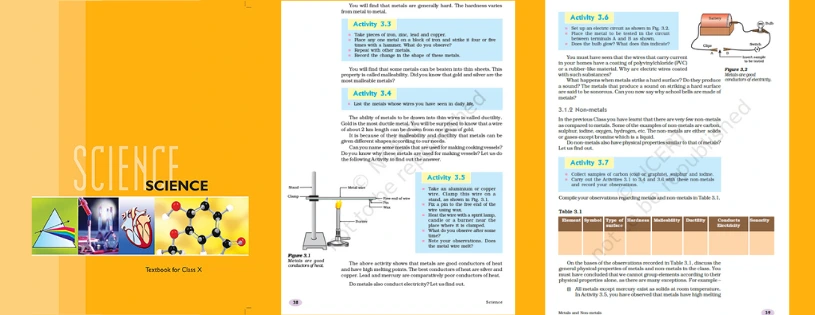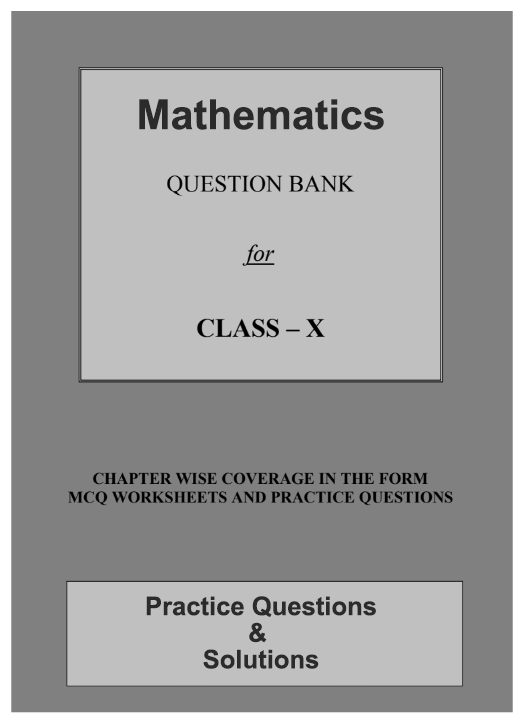As we navigate through the diverse landscapes of conductivity, malleability, ductility, and other defining traits, the CBSE NCERT downloads become our compass, providing a structured and insightful approach to understanding these fundamental concepts. With a focus on clarity and precision, our journey into the properties of metals and non-metals promises to be an enriching experience, guided by the trusted educational framework of CBSE NCERT.
Unlocking the World of Chemistry: CBSE NCERT Downloads on the Properties of Metals and Non-Metals
Properties of Metals
Examples of metals are gold, aluminum, iron, and magnesium, etc.. They show the following properties.
-
Physical Properties of Metals: Some of the main physical properties of metals are given below.
-
Metals can be hammered into thin sheets. It means they possess the property of malleability.
-
Metals are ductile. They can be drawn into wires.
-
Metals are a good conductor of heat and electricity.
-
Metals are lustrous which means they have a shiny appearance.
-
Metals have high tensile strength. It means they can hold heavyweights.
-
Metals are sonorous. It means when we strike them, they make a ringing sound.
-
Metals are hard. It means they cannot be cut easily.
Chemical Properties of Metals: Some of the chemical properties of metals are given below.
-
Reaction with Oxygen – Metals react with oxygen and form metallic oxides which are basic in nature.
Metal + Oxygen Metal oxide
Metal oxide + water Base
Example –Magnesium is metal and when it reacts with oxygen, it forms magnesium oxide. When we dissolve magnesium oxide in water, it gives magnesium hydroxide. The reactions are given below.
2Mg + O2 2MgO
MgO + H2O Mg(OH)2
-
An aqueous solution of metal oxide turns red litmus paper into blue.
-
Reaction with water – Metals react with water. When a metal reacts with water, metal hydroxide and hydrogen gas are formed.
Metal + Water Metal hydroxide + hydrogen
Example – Sodium metal reacts with water and forms sodium hydroxide and hydrogen gas. The reaction is given below –
Na + H2O NaOH + H2
-
Reaction With Acid – Metals react with acids and form salt and hydrogen gas. Some metals vigorously react with acids.
Metal + Acid Metal salt + hydrogen
Example – Magnesium metal reacts with hydrochloric acid and forms magnesium chloride and hydrogen. The reaction is given below –
Mg + 2HCl MgCl2 + H2
-
Reaction With Base – Metals react with bases such as sodium hydroxide and form salt and hydrogen gas.
Metal + Base Metal salt + hydrogen
Example – Aluminium metal reacts with Sodium hydroxide and forms sodium aluminate and hydrogen gas. The reaction is given below –
Al + NaOH NaAlO2 + H2
-
Displacement Reaction – A more reactive metal displaces a less reactive metal from its salt solution. These types of reactions are called displacement reactions.
Example – Iron is more reactive than copper. So, it displaces copper from its salt. The reaction is given below –
CuSO4 + Fe FeSO4 + Cu

I. Metallic Marvels:
-
Conductivity:
- One of the most distinguishing features of metals is their excellent conductivity of electricity and heat. This property makes metals invaluable in electrical wiring, electronics, and various industrial applications.
-
Malleability and Ductility:
- Metals possess the ability to be hammered into thin sheets (malleability) and drawn into thin wires (ductility) without breaking. This property is exploited in the manufacturing of coins, aluminum foils, and structural materials.
-
Luster:
- Metals exhibit a characteristic shine or luster due to the reflection of light from their surfaces. This property contributes to the aesthetic appeal of jewelry and decorative items.
-
High Melting and Boiling Points:
- Metals generally have high melting and boiling points, making them suitable for applications where they are exposed to extreme temperatures, such as in the production of machinery and engines.
II. Non-Metallic Wonders:
-
Poor Conductivity:
- In stark contrast to metals, non-metals are generally poor conductors of electricity and heat. This property makes them suitable for insulation purposes, such as in electrical wires and household appliances.
-
Brittleness:
- Non-metals are often brittle and break easily when subjected to stress. This characteristic limits their use in structural applications but finds applications in materials like ceramics.
-
Dull Appearance:
- Unlike metals, non-metals lack the characteristic luster and generally have a dull appearance. This property influences their use in various everyday items, such as plastics and rubber.
-
Low Melting and Boiling Points:
- Non-metals typically have lower melting and boiling points compared to metals. This property is advantageous in applications where low-temperature resistance is crucial, such as in producing certain chemicals.
III. Applications in Everyday Life:
-
Metals in Transportation:
- The automotive and aerospace industries heavily rely on metals like aluminum and titanium due to their strength, lightweight nature, and corrosion resistance.
-
Non-Metals in Packaging:
- Plastics and polymers, which are non-metals, play a pivotal role in packaging materials, providing flexibility, durability, and resistance to moisture.
-
Metals in Electronics:
- The conductivity of metals makes them essential in the manufacturing of electronic components, from wires and connectors to semiconductors.
-
Non-Metals in Healthcare:
- Non-metals like silicon are crucial in medical applications, particularly in the production of semiconductors used in medical imaging devices and diagnostic equipment.
CBSE Class 10th Downloadable Resources:
| 1. CBSE Class 10th Topic Wise Summary | View Page / Download |
| 2. CBSE Class 10th NCERT Books | View Page / Download |
| 3. CBSE Class 10th NCERT Solutions | View Page / Download |
| 4. CBSE Class 10th Exemplar | View Page / Download |
| 5. CBSE Class 10th Previous Year Papers | View Page / Download |
| 6. CBSE Class 10th Sample Papers | View Page / Download |
| 7. CBSE Class 10th Question Bank | View Page / Download |
| 8. CBSE Class 10th Topic Wise Revision Notes | View Page / Download |
| 9. CBSE Class 10th Last Minutes Preparation Resources (LMP) | View Page / Download |
| 10. CBSE Class 10th Best Reference Books | View Page / Download |
| 11. CBSE Class 10th Formula Booklet | View Page / Download |
Being in CBSE class 10th and considering the board examinations you must be needing resources to excel in your examinations. At TestprepKart we take great pride in providing CBSE class 10th all study resources in downloadable form for you to keep you going.
Below is the list of all CBSE class 10th Downloads available on TestprepKart for both Indian and NRI students preparing for CBSE class 10th in UAE, Oman, Qatar, Kuwait & Bahrain.
SAMPLE PRACTICE QUESTION
Q1: What are the key characteristics that distinguish metals from non-metals?
Ans: Metals and non-metals exhibit distinct properties. Metals generally have high conductivity, malleability, and luster, whereas non-metals tend to be poor conductors with a dull appearance.
Q2: How does the CBSE NCERT guide enhance understanding of the properties of metals and non-metals?
Ans: The CBSE NCERT guide provides a comprehensive and structured approach to learning about the properties of metals and non-metals, offering clear explanations and practical insights for students.
Q3: What role do metals play in everyday applications, especially in transportation and electronics?
Ans: Metals, such as aluminum and copper, are crucial in transportation due to their strength and conductivity. In electronics, metals are used for wiring and semiconductor components.
Q4: Can you explain the significance of non-metals in packaging materials and healthcare applications?
Ans: Non-metals, like plastics and polymers, contribute to flexible and durable packaging materials. In healthcare, non-metals like silicon are vital for medical imaging devices and diagnostic equipment.
Q5: How do the properties of metals and non-metals contribute to their applications in various industries?
Ans: The unique properties of metals, such as conductivity and malleability, make them suitable for applications in industries like automotive, aerospace, and electronics. Non-metals find uses in areas where properties like insulation and low-temperature resistance are crucial.

| CBSE CLASS 10 Mathematics Chapters |
| Chapter1: Real Numbers |
| Chapter2: Polynomials |
| Chapter3: Pair of Linear Equations in Two Variables |
| Chapter4: Quadratic Equations |
| Chapter5: Arithmetic Progressions |
| Chapter6: Triangles |
| Chapter7: Coordinate Geometry |
| Chapter8: Introduction to Trigonometry |
| Chapter9: Some Applications of Trigonometry |
| Chapter10: Circles |
| Chapter11: Areas Related to Circles |
| Chapter12: Surface Areas and Volumes |
| Chapter13: Statistics |
| Chapter14: Probability |
| CBSE CLASS 10 Science Chapters |
| Chapter1: Chemical Reactions and Equations |
| Chapter2: Acids, Bases and Salts |
| Chapter3: Metals and Non-metals |
| >Reactivity Series |
| >Formation and Properties of Ionic Compounds |
| >Basic Metallurgical Processes |
| >Corrosion and its Prevention |
| Chapter4: Carbon and its Compounds |
| Chapter5: Life Processes |
| Chapter6: Control and Coordination |
| Chapter7: How do Organisms Reproduce? |
| Chapter8: Heredity |
| Chapter9: Light – Reflection and Refraction |
| Chapter10: The Human Eye and the Colourful World |
| Chapter11: Electricity |
| Chapter12: Magnetic Effects of Electric Current |
| Chapter13: Our Environment |
| Class 8 |
| Class 9 |
| Class 11 |
| Class 12 |
Leave a Reply